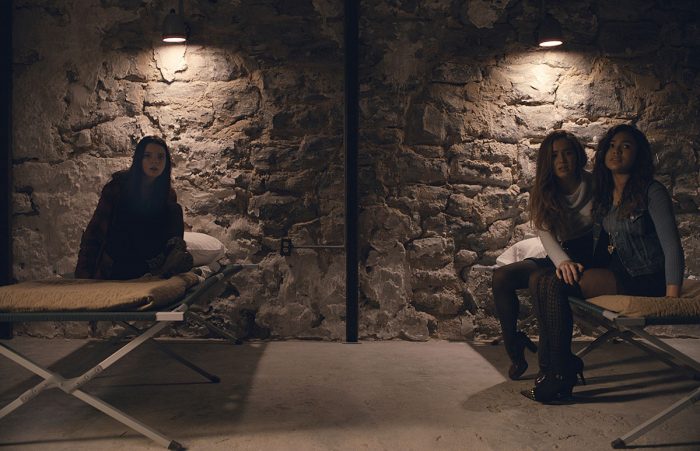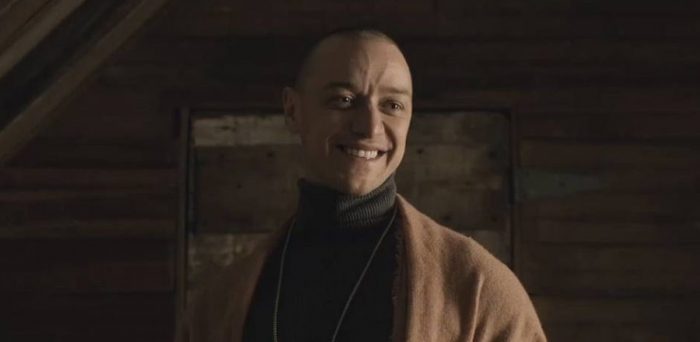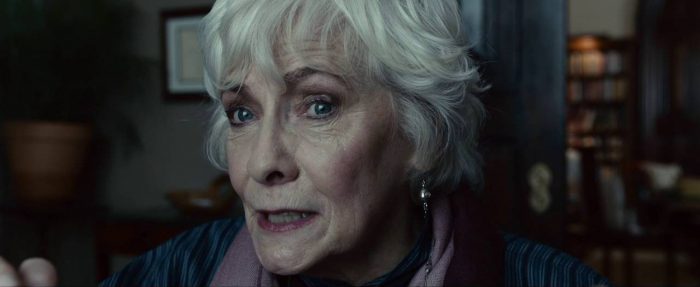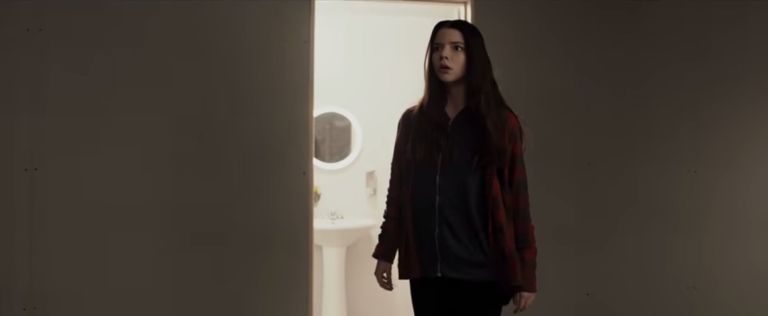No spoilers for twists or major plot points; detailed discussion of themes and characters.
From myths and fairytales to parables and comic books, stories shape our world. Their characters not only entertain and enchant us, they instil values, give lessons, teach empathy, and inspire us with their journeys. Even mythic adventurers and seemingly-invulnerable superheroes rarely achieve their goals without a struggle, and by witnessing their tenacity we nurture our own. Well-told stories can educate us and expand our minds… but poorly-told stories can offer a fractured reflection of life, sending ugly messages which could actively harm and mislead their audiences. M. Night Shyamalan‘s Split boldly asserts that it is “based on a true story”, the first of its exaggerated intimations of empirical fact. The story in question is that of Billy Milligan, a felon whose lawyers used his diagnosis of Multiple Personality Disorder (now reclassified as Dissociative Identity Disorder, or DID) to get him out of three campus rape charges, as well as charges for kidnapping and aggravated robbery. This was in the 1970s; he was the first person to use MPD as a defence and the first to be acquitted of major crimes for this reason.
In Split, James McAvoy plays Kevin, a deeply traumatised man who is host to a total of 24 different personalities, or “alters” (eight of which we see onscreen). McAvoy’s performance is virtuosic – sometimes we see his alters visibly change right in front of us – and the actor’s evident sensitivity towards Kevin’s character and his disorder lend sympathy and veracity to McAvoy’s portrayal. In the service of one of his more beastly alters, Kevin kidnaps three young women and imprisons them in the kind of ‘pervert dungeon’ we’re way too used to seeing, both in nauseating real life cases and dramatisations like Unbreakable Kimmy Schmidt. Every time Kevin shows up at their door, his petrified captives need to figure out which one of his bizarre personalities they’ll have to deal with, and plot their escape before Kevin can enact whatever creepy plans his alters have in mind.

Villains do bad things to good people in real life, so it’s understandable that we represent this in our storytelling. But exactly how we represent our villains has consequences: if we glamorise or stigmatise the wrong things, we run the risk of normalising the unacceptable and accepting the unworthy. Well before Dr Jekyll and Mr Hyde, storytellers became fascinated by the notion that our very identities may not be under our control and can be taken from us by mental illness or supernatural means. Since the 1950s, a sizable category of movies featuring MPD or DID has developed, including Psycho; Sybil; The Three Faces of Eve; Secret Window; Raising Cain; Me, Myself and Irene, and the TV series The United States of Tara.
DID is surprisingly over-represented on screen, considering that The International Society for the Study of Trauma and Dissociation states that the prevalence of DID is between 1 and 3% in the general population, and between 1 and 5% in inpatient groups in Europe and North America. Its incidence in reality is vanishingly rare, and some experts argue that it doesn’t exist at all or that it may be therapist-induced; it’s arguably the most controversial of all the dissociative disorders. Since the 1950s, there has been an uptick in the diagnosis of DID, and since the ’90s it has been used more frequently as a legal defence in court cases. This could be due to better understanding of the condition… or a result of its unusually common depictions in popular culture.
In movies like Split, DID is typically shown as the motivation for a central character to commit a horrible crime, which is a cruel irony given that people living with mental illness are ten times more likely to be the victim of a crime than to perpetrate one. It’s correct to say that people with mental health problems are neither violent nor unpredictable; in fact, their vulnerability can put them in danger. 90% of mentally ill people have no history of violence, which would tend to indicate the much more disturbing reality that the vast majority of violent crimes are committed by people who are perfectly aware of what they are doing. Shyamalan’s script (and his direction of it) perpetuates and exacerbates the stigma around mental illness. This both enhances the risks experienced by people who have a diagnosis, and discourages others from seeking help. In Australia, one in every five people experiences a mental illness of some sort each year – such as anxiety, substance abuse disorders, seasonal and post-natal depression – but because of the disgrace we unfairly attach to a lack of mental wellness, advocates are fighting an uphill battle in encouraging people to seek the treatment they need.
Shyamalan spins science into pseudoscience and then into science fiction. By foregrounding the idea that Split is based on a true story, he exploits community fears and morbidly leverages the suffering of everyone who is actually affected by DID and similar conditions. Considering that DID often occurs as a coping mechanism following child abuse, this is in dubious taste. He seamlessly moves from factual explanations of what is understood about DID (e.g. its possible roots in childhood trauma) into wildly speculative imaginings about individuals’ abilities (a blind man with DID whose alters could see), and onward into sci-fi (wherein the human is made superhuman). What’s more, using his auteur trademark of trope inversion (reversing cliches to create his signature “twist”), Shyamalan manages to bestow surprising abilities upon some of his characters, adding the Magical Madman to the trope club of Magical Negros, Asians and Queers.

There are other issues. Shyamalan dwells on the first appearance of Kevin’s feminine alter (the quietly menacing Patricia) as though the sight of a male appearing effeminate and wearing a skirt is something inherently sick and disturbing. Kevin’s dominant alter – the one capable of going out to visit his psychiatrist – is Barry, a slightly camp Queer fashion designer. There’s something disquieting and cliched about Shyamalan’s writing of these two characters, which is barely redeemed by McAvoy’s trustworthy performance. Meanwhile, an apparently male child alter has the female name Hedwig (and your guess is as good as mine about why); his youthful disinhibition makes him one of the more interesting personas.

With respect to the other characters, Betty Buckley turns in a great performance as Kevin’s psychiatrist, Dr Fletcher (a renowned DID expert), but is lumped with loads of expositional dialogue and embarrassing pseudopsychiatry. (Someone please confiscate Mr Shyamalan’s copy of the DSM-V before he continues to use it as a blunt instrument). Anya Taylor-Joy is strong as Casey, the kidnap victim with enough trauma in her own past to try to outwit Kevin’s horde of alters. In the process of telling Casey’s backstory, Shyamalan mines her childhood for gory details and we come away with the disturbing messages that minors should learn to fire shotguns and that self-harm (e.g. cutting) might just save your soul. The other two teen girls (poor old Hayley Lu Richardson and Jessica Sula) stereotypically serve only as plot fodder and panty-clad eye candy. These are downright irresponsible depictions; it boggles the mind to think that Shyamalan doesn’t know better than to write them. He also manages to insert an unnecessary and self-indulgent cameo that includes a plug for Hooters, and eventually references his own ‘Shyamaverse’ storyworld, implying that all the suffering we’ve seen in the movie is merely in the service of some future plot. It’s such a pity, because his films are so strong in their craft and several of them (notably The Sixth Sense) came off perfectly. Considering the much more uplifting and less pejorative directions this story could have gone in, Split is a disappointment.
Amongst creative professionals, there’s an ongoing debate about whether the artist has any responsibility other than to create art. Many argue that the work doesn’t have to serve a purpose or take any social responsibility whatsoever; it is the artist’s prerogative simply to make their statement. Others take the opposite view, specifically creating stories with a view to the social good (for example, Participant Media, who made Spotlight, The Help, Deepwater Horizon, Good Night and Good Luck, The Cove, An Inconvenient Truth and dozens more). The late actor, Alan Rickman, remarked “It’s a human need to be told stories. The more we’re governed by idiots and have no control over our destinies, the more we need to tell stories to each other about who we are, why we are, where we come from, and what might be possible.”
Stories are tools: they can be used to connect and inspire us, but also as weapons to divide us and make us fear others. Split is just another story that pretends to know the facts but is harmful in its distortions of reality. Remember, fake stories can hurt real people.


